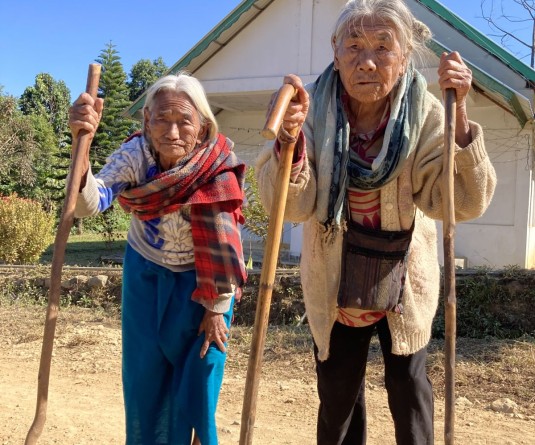
South west monsoon (from June till date) rainfall over Nagaland as per India Meteorological Department is normal for Mokokchung, Kiphire and Peren but is deficient for the remaining district.
Keeping in view of threat of COVID-19 spread farmers are advised to follow the government guidelines, personal hygiene, use mask, ensure hand washing with soap at reasonable interval, social distancing during picking of vegetables and other agricultural operation in all crops.
Crop Advisories
Agronomic measures - repeated interculture should be done to remove weeds and create soil mulch to conserve soil moisture. Avoid top-dressing of fertilizers until receipt of rains. Foliar spray should be carried out to supplement nutrition during dry spells. Surface mulching with crop residues, provide supplemental irrigation (10 cm depth), if available.
• Judiciously use the available water.
• Ensure sowing of winter season intercrops in young orchards.
• Undertake rainwater harvesting. Water harvesting practices like farm ponds, community tanks, watersheds and pools can prove a life saver.
• Use drought-resistant / low water requiring crop varieties / plants. Plant drought-tolerant grasses, shrubs, trees to protect soil moisture.
• Irrigate crops during evenings.
• Remove the weeds from fields. Those weeds can be used for mulching to avoid water loss. Take up hoeing or intercultural operations to make soil dust mulch to conserve soil moisture, remove weeds and break soil surface crust.
• Crops with short duration and requiring relatively little water need to be encouraged.
• Foliar spray of nitrogen fertilizers and micronutrients during the dry spell protects and improves the endurance of crop to the drought conditions.
• Ginger: Ginger crop may be harvested when the foliages turn yellow and drop off (generally takes 7-8 months to mature).
For seed rhizomes, the ginger rhizomes should be allowed to mature adequately (8-9 months) and efficient storage techniques should be adopted to minimize the storage loss and conserve the seed rhizomes before the ensuing planting season. It may be stored in a pit of convenient size in sheds, where the walls of the pits may be coated with cowdung paste. Place the seed rhizomes in the pits in layers along with well dried sand/sawdust/straw and plaster the pit with a paste of cowdung and mud, keeping one or two small holes for aeration.
• Time for growing of rabi crops after harvest of upland rice/maize taking the advantages of residual soil moisture and mulching in rabi crops will give additional yield advantages.
• Field preparation should be started for rabi crops. Ploughing and planking should be done properly to conserve the moisture in the soil.
• Bunds, channels, uncultivated fields and field roads should be cleaned by removing weeds also use fully decomposed FYM or compost before sowing of crops and vegetable as it improves the physical and biological properties of soil and thus increases the water retention capacity as well as nutrient status of the soil.
• Deep ploughing should be done to expose the soil borne pathogens and hibernating stage of defoliators. Follow clean cultivation.
• Transplant marigold as trap crop (1 row /14 rows of tomato) 15 days older than tomato seedling.
• Grow mustard as a trap crop in cole crops after every 10 lines.
• Early sowing should be done to avoid damage due to mustard-aphid, and major diseases.
• Monitor the plants for white flies population and spray neem oil 5ml/lt water or spray imidacloprid @0.1% at heavy infestation stage. It should be done during clear/ dry days.
Livestock Advisories
Poultry:
1. Brooder lights should be kept switched on before introducing chicks into the brooding area. Brooder room should be warm but well ventilated.
2. Observe for abnormalities in colour and consistency of droppings.
3. Immediately isolate sick and inactive birds. Inactive and sick birds will have ruffled feathers, dropping wings and may appear sleepy.
4. Sneezing, breathing rales and nasal/occular discharges should be observed and birds exhibiting these should be isolated and treated.
5. Avoid over feeding of layer birds. Broilers may be fed adlibitum.
6. Avoid mixing up birds of different ages.
7. Deworming and vaccination should be carried out regularly and on schedule even for local/desi birds.
Piggery:
1. Maintain strict biosecurity protocol.
2. Sows farrowing more than 10 piglets/older sows on farrowing should be provided proper care during and after farrowing.
3. When excess piglets are farrowed some of the piglets can be fostered after colostrums feeding. Artificial feeding of milk can also be carried out for the piglets.
4. When new piglets are brought they should be continued on a ration similar to the previous ration provided by the owner and slowly the ration can be tapered off.
5. Freshly purchased piglets can be provided multivitamins and ORS in drinking water to help combat stress.
6. Provide warmth in the winter months to piglets as they are highly susceptible to cold stress mortality.
7. Deworm and vaccinate on schedule.




